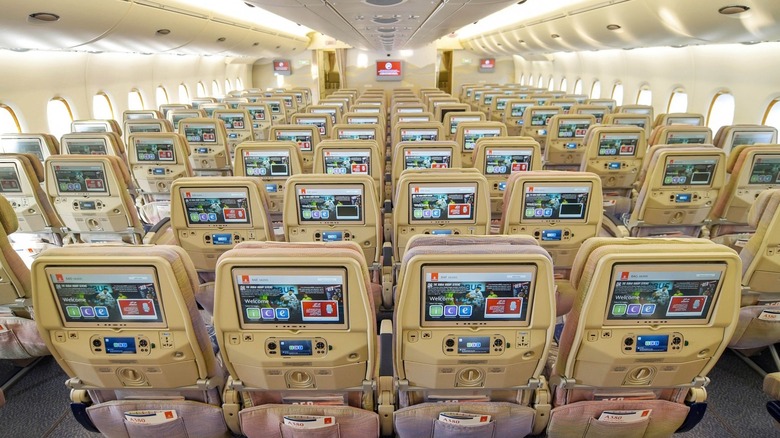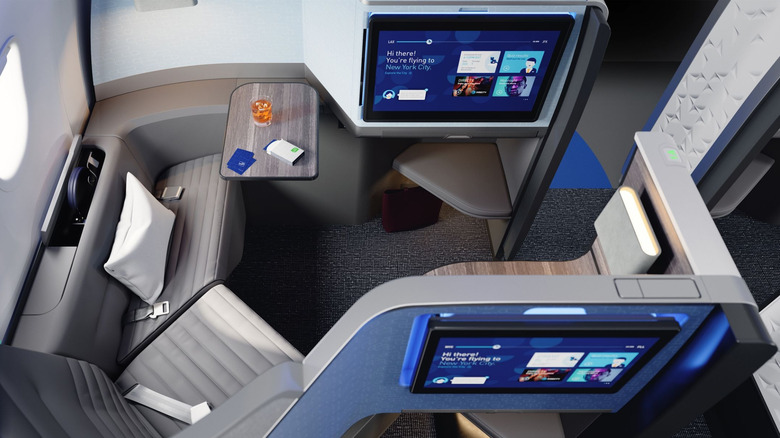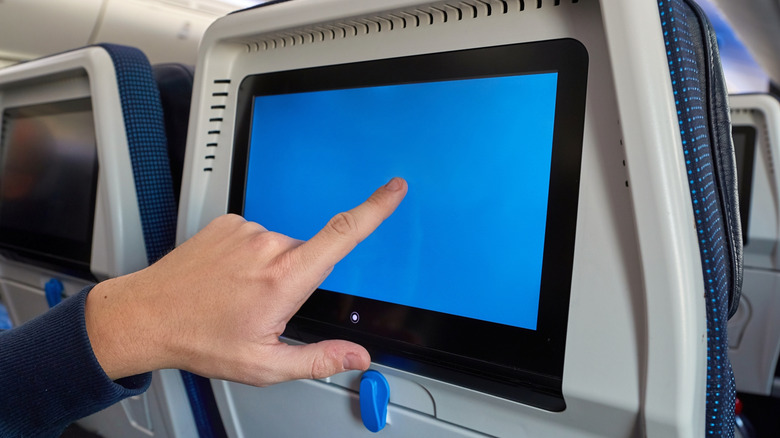Which Airline Has The Largest Seatback TV Screens?
Before the rise of personal devices, passengers relied solely on what airlines provided onboard: scratchy radio channels, drop-down screens showing a single movie, and basic audio jacks built into armrests. Over time, airlines realized that keeping travelers entertained made long flights much more bearable — and much more competitive.
In the 1980s, in-flight entertainment took off, with Northwest Airlines pioneering early seatback screens. Fast forward to today, and most long-haul widebody aircraft from major U.S. airlines like Delta, United, and American boast such screens. Better yet, these systems are loaded with movies, TV shows, audiobooks, games, and live maps. You can also connect Bluetooth headphones to your in-flight entertainment screen for a truly personalized, private experience. Some carriers like Virgin Atlantic even used to let passengers chat seat-to-seat via the in-flight entertainment system, though some unruly incidents eventually led to the feature's removal.
Still, even as the tech has evolved, not every aircraft has the high-tech features we want to see in commercial airline flights. Narrowbody aircraft often rely on streaming to personal devices instead of dedicated screens, a trend that's only accelerated lately. But among those still doing seatback entertainment justice, a few airlines really stand out, especially when it comes to screen size.
Which carriers give you the most screen space?
Not all in-flight entertainment screens are created equal, especially when it comes to size. There's a big difference between the massive displays in first-class suites and the actual seatback TVs you tap through in economy. When it comes to true seatback screens — meaning screens mounted directly behind the seat in front of you — Lufthansa currently leads the pack. The airline offers 15.6-inch seatback displays in premium economy, making them the largest of their kind flying today. They boast a 4K resolution, too.
Right behind are Japan Airlines and Emirates, both offering 13.3-inch seatback screens in economy, while Singapore Airlines has that size in premium economy. JAL's are found on its new Airbus A350-1000s, while Emirates features them across its Boeing 777 and Airbus A380 fleets, and Singapore on A350s, A380s and Boeing 777s. Qatar Airways rounds out the list with 10.6-inch screens.
If you move up to first and business class, things get even bigger. But these screens are usually mounted on the suite shell or partition walls, not literally on a seatback. For instance, Japan Airlines and All Nippon Airways both boast whopping 43-inch first-class screens. Emirates' first-class passengers get 32-inch displays, and Qatar offers a 26-inch screen in first. Over in business, JAL's 24-inch screens and Emirates' 23-inch units stand out. But if you're focused specifically on the largest screens mounted to the back of a seat, Lufthansa takes the top spot.
But seatback screens are fading away
Despite all the goodies in-flight entertainment offers, airlines are starting to rethink whether seatback screens are worth it. First, the cost is enormous — installing seatback screens averages about $10,000 per seat, not to mention maintenance, content licensing, and constant updates. Reports suggest that removing them helps airlines save a ton on expenses.
Weight is another major concern. Screens and wiring add pounds that airlines would much rather ditch. Less weight means lower fuel consumption, which cuts both costs and emissions — important as the industry faces mounting pressure to go greener. On top of that, travelers today rarely board a plane without their own device packed with movies, music, and games. Streaming content through onboard Wi-Fi is becoming the new norm. Delta, United, and JetBlue even offer free texting via WhatsApp and iMessage.
Not everyone would be thrilled with this, though. Business travelers in particular appreciate having a separate screen to work and watch simultaneously, and some flyers worry about draining their phone batteries mid-flight — especially on routes without USB outlets. But for airlines, the math is simple: lighter planes, fewer technical glitches, and lower costs.


